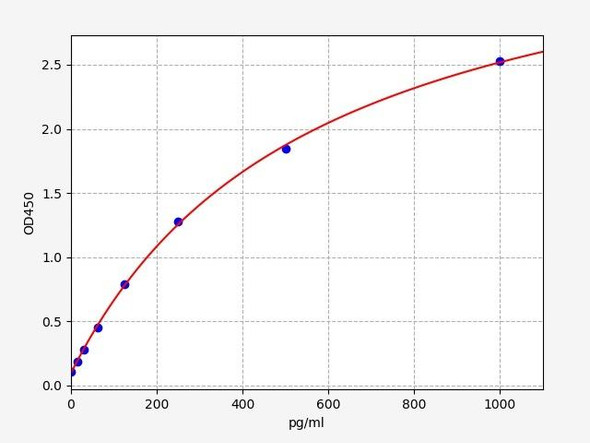Description
Rat Alpha-synuclein (Snca) ELISA Kit
The Rat Alpha-Synuclein (SNCA) ELISA Kit is a reliable tool for measuring levels of alpha-synuclein in rat serum, plasma, and cell culture supernatants. This kit offers high sensitivity and specificity, ensuring accurate and reproducible results for a variety of research applications.Alpha-synuclein is a key protein involved in the pathogenesis of neurodegenerative disorders such as Parkinson's disease.
By measuring levels of alpha-synuclein, researchers can gain valuable insights into disease progression and potential therapeutic targets. This kit provides a valuable tool for studying alpha-synuclein in rat models, offering researchers a comprehensive solution for their experiments.
| Product Name: | Rat Alpha-synuclein (Snca) ELISA Kit |
| SKU: | RTEB0771 |
| Size: | 96T |
| Target: | Rat Alpha-synuclein (Snca) |
| Synonyms: | Alpha-synuclein, Snca |
| Assay Type: | Sandwich |
| Detection Method: | ELISA |
| Reactivity: | Rat |
| Detection Range: | 0.78-50ng/mL |
| Sensitivity: | 0.39ng/mL |
| Intra CV: | 4.9% | ||||||||||||||||||||
| Inter CV: | 9.0% | ||||||||||||||||||||
| Linearity: |
| ||||||||||||||||||||
| Recovery: |
| ||||||||||||||||||||
| Function: | May be involved in the regulation of dopamine release and transport. |
| Uniprot: | P37377 |
| Sample Type: | Serum, plasma, tissue homogenates, cell culture supernates and other biological fluids |
| Specificity: | Natural and recombinant rat Alpha-synuclein |
| Sub Unit: | Interacts with UCHL1. |
| Research Area: | Neurosciences |
| Subcellular Location: | Cytoplasm Cytosol Membrane Nucleus Cell junction Synapse Secreted |
| Storage: | Please see kit components below for exact storage details |
| Note: | For research use only |
| UniProt Protein Function: | SNCA: a member of the synuclein family. Abundantly expressed in the brain. Inhibits phospholipase D2 selectively. May integrate presynaptic signaling and membrane trafficking. Implicated in the pathogenesis of Parkinson's disease. A major component of amyloid plaques in the brains of patients with Alzheimer's disease. Two alternatively spliced isoforms transcripts have been identified. |
| UniProt Protein Details: | Protein type:Adaptor/scaffold Cellular Component: actin cytoskeleton; axon; cell cortex; cell junction; cytoplasm; cytoplasmic vesicle membrane; cytoskeleton; cytosol; extracellular space; fibril; Golgi apparatus; growth cone; inclusion body; intracellular membrane-bound organelle; membrane; mitochondrion; nerve terminal; nuclear outer membrane; nucleus; perinuclear region of cytoplasm; plasma membrane; platelet alpha granule membrane; ribosome; rough endoplasmic reticulum; synapse; synaptic vesicle; terminal button Molecular Function:alpha-tubulin binding; arachidonic acid binding; beta-tubulin binding; calcium ion binding; caspase inhibitor activity; copper ion binding; dynein binding; enzyme binding; fatty acid binding; ferrous iron binding; histone binding; identical protein binding; kinesin binding; magnesium ion binding; microtubule binding; oxidoreductase activity; phospholipase binding; phospholipid binding; phosphoprotein binding; protein binding; protein domain specific binding; protein N-terminus binding; tau protein binding; zinc ion binding Biological Process: adult locomotory behavior; aging; behavioral response to cocaine; calcium ion homeostasis; caspase activation; dopamine biosynthetic process; dopamine metabolic process; fatty acid metabolic process; microglial cell activation; mitochondrial membrane organization and biogenesis; negative regulation of apoptosis; negative regulation of caspase activity; negative regulation of dopamine metabolic process; negative regulation of dopamine uptake; negative regulation of exocytosis; negative regulation of histone acetylation; negative regulation of microtubule polymerization; negative regulation of monooxygenase activity; negative regulation of neuron apoptosis; negative regulation of norepinephrine uptake; negative regulation of protein amino acid phosphorylation; negative regulation of serotonin uptake; negative regulation of transporter activity; neutral lipid metabolic process; organelle ATP synthesis coupled electron transport; phospholipid metabolic process; positive regulation of endocytosis; positive regulation of neurotransmitter secretion; positive regulation of peptidyl-serine phosphorylation; positive regulation of receptor recycling; positive regulation of release of sequestered calcium ion into cytosol; positive regulation of synaptic transmission; protein destabilization; receptor internalization; regulation of acyl-CoA biosynthetic process; regulation of dopamine secretion; regulation of excitatory postsynaptic membrane potential; regulation of glutamate secretion; regulation of locomotion; regulation of long-term neuronal synaptic plasticity; regulation of macrophage activation; regulation of neuron apoptosis; regulation of neuronal synaptic plasticity; regulation of neurotransmitter secretion; response to cocaine; response to drug; response to iron(II) ion; response to lipopolysaccharide; response to magnesium ion; synapse organization and biogenesis; synaptic transmission; synaptic transmission, dopaminergic; synaptic vesicle endocytosis; synaptic vesicle transport |
| NCBI Summary: | may play a role in regulation of synaptic vesicle biogenesis and organization; may be involved in neurotransmission [RGD, Feb 2006] |
| UniProt Code: | P37377 |
| NCBI GenInfo Identifier: | 9507125 |
| NCBI Gene ID: | 29219 |
| NCBI Accession: | NP_062042.1 |
| UniProt Secondary Accession: | P37377,P37378, Q53YM9, |
| UniProt Related Accession: | P37377 |
| Molecular Weight: | 41.9kD |
| NCBI Full Name: | alpha-synuclein |
| NCBI Synonym Full Names: | synuclein alpha |
| NCBI Official Symbol: | Snca |
| NCBI Protein Information: | alpha-synuclein |
| UniProt Protein Name: | Alpha-synuclein |
| Protein Family: | Alpha-synuclein |
| UniProt Gene Name: | Snca |
| UniProt Entry Name: | SYUA_RAT |
| Component | Quantity (96 Assays) | Storage |
| ELISA Microplate (Dismountable) | 8×12 strips | -20°C |
| Lyophilized Standard | 2 | -20°C |
| Sample Diluent | 20ml | -20°C |
| Assay Diluent A | 10mL | -20°C |
| Assay Diluent B | 10mL | -20°C |
| Detection Reagent A | 120µL | -20°C |
| Detection Reagent B | 120µL | -20°C |
| Wash Buffer | 30mL | 4°C |
| Substrate | 10mL | 4°C |
| Stop Solution | 10mL | 4°C |
| Plate Sealer | 5 | - |
Other materials and equipment required:
- Microplate reader with 450 nm wavelength filter
- Multichannel Pipette, Pipette, microcentrifuge tubes and disposable pipette tips
- Incubator
- Deionized or distilled water
- Absorbent paper
- Buffer resevoir
*Note: The below protocol is a sample protocol. Protocols are specific to each batch/lot. For the correct instructions please follow the protocol included in your kit.
Allow all reagents to reach room temperature (Please do not dissolve the reagents at 37°C directly). All the reagents should be mixed thoroughly by gently swirling before pipetting. Avoid foaming. Keep appropriate numbers of strips for 1 experiment and remove extra strips from microtiter plate. Removed strips should be resealed and stored at -20°C until the kits expiry date. Prepare all reagents, working standards and samples as directed in the previous sections. Please predict the concentration before assaying. If values for these are not within the range of the standard curve, users must determine the optimal sample dilutions for their experiments. We recommend running all samples in duplicate.
| Step | |
| 1. | Add Sample: Add 100µL of Standard, Blank, or Sample per well. The blank well is added with Sample diluent. Solutions are added to the bottom of micro ELISA plate well, avoid inside wall touching and foaming as possible. Mix it gently. Cover the plate with sealer we provided. Incubate for 120 minutes at 37°C. |
| 2. | Remove the liquid from each well, don't wash. Add 100µL of Detection Reagent A working solution to each well. Cover with the Plate sealer. Gently tap the plate to ensure thorough mixing. Incubate for 1 hour at 37°C. Note: if Detection Reagent A appears cloudy warm to room temperature until solution is uniform. |
| 3. | Aspirate each well and wash, repeating the process three times. Wash by filling each well with Wash Buffer (approximately 400µL) (a squirt bottle, multi-channel pipette,manifold dispenser or automated washer are needed). Complete removal of liquid at each step is essential. After the last wash, completely remove remaining Wash Buffer by aspirating or decanting. Invert the plate and pat it against thick clean absorbent paper. |
| 4. | Add 100µL of Detection Reagent B working solution to each well. Cover with the Plate sealer. Incubate for 60 minutes at 37°C. |
| 5. | Repeat the wash process for five times as conducted in step 3. |
| 6. | Add 90µL of Substrate Solution to each well. Cover with a new Plate sealer and incubate for 10-20 minutes at 37°C. Protect the plate from light. The reaction time can be shortened or extended according to the actual color change, but this should not exceed more than 30 minutes. When apparent gradient appears in standard wells, user should terminatethe reaction. |
| 7. | Add 50µL of Stop Solution to each well. If color change does not appear uniform, gently tap the plate to ensure thorough mixing. |
| 8. | Determine the optical density (OD value) of each well at once, using a micro-plate reader set to 450 nm. User should open the micro-plate reader in advance, preheat the instrument, and set the testing parameters. |
| 9. | After experiment, store all reagents according to the specified storage temperature respectively until their expiry. |
When carrying out an ELISA assay it is important to prepare your samples in order to achieve the best possible results. Below we have a list of procedures for the preparation of samples for different sample types.
| Sample Type | Protocol |
| Serum | If using serum separator tubes, allow samples to clot for 30 minutes at room temperature. Centrifuge for 10 minutes at 1,000x g. Collect the serum fraction and assay promptly or aliquot and store the samples at -80°C. Avoid multiple freeze-thaw cycles. If serum separator tubes are not being used, allow samples to clot overnight at 2-8°C. Centrifuge for 10 minutes at 1,000x g. Remove serum and assay promptly or aliquot and store the samples at -80°C. Avoid multiple freeze-thaw cycles. |
| Plasma | Collect plasma using EDTA or heparin as an anticoagulant. Centrifuge samples at 4°C for 15 mins at 1000 × g within 30 mins of collection. Collect the plasma fraction and assay promptly or aliquot and store the samples at -80°C. Avoid multiple freeze-thaw cycles. Note: Over haemolysed samples are not suitable for use with this kit. |
| Urine & Cerebrospinal Fluid | Collect the urine (mid-stream) in a sterile container, centrifuge for 20 mins at 2000-3000 rpm. Remove supernatant and assay immediately. If any precipitation is detected, repeat the centrifugation step. A similar protocol can be used for cerebrospinal fluid. |
| Cell culture supernatant | Collect the cell culture media by pipette, followed by centrifugation at 4°C for 20 mins at 1500 rpm. Collect the clear supernatant and assay immediately. |
| Cell lysates | Solubilize cells in lysis buffer and allow to sit on ice for 30 minutes. Centrifuge tubes at 14,000 x g for 5 minutes to remove insoluble material. Aliquot the supernatant into a new tube and discard the remaining whole cell extract. Quantify total protein concentration using a total protein assay. Assay immediately or aliquot and store at ≤ -20 °C. |
| Tissue homogenates | The preparation of tissue homogenates will vary depending upon tissue type. Rinse tissue with 1X PBS to remove excess blood & homogenize in 20ml of 1X PBS (including protease inhibitors) and store overnight at ≤ -20°C. Two freeze-thaw cycles are required to break the cell membranes. To further disrupt the cell membranes you can sonicate the samples. Centrifuge homogenates for 5 mins at 5000xg. Remove the supernatant and assay immediately or aliquot and store at -20°C or -80°C. |
| Tissue lysates | Rinse tissue with PBS, cut into 1-2 mm pieces, and homogenize with a tissue homogenizer in PBS. Add an equal volume of RIPA buffer containing protease inhibitors and lyse tissues at room temperature for 30 minutes with gentle agitation. Centrifuge to remove debris. Quantify total protein concentration using a total protein assay. Assay immediately or aliquot and store at ≤ -20 °C. |
| Breast Milk | Collect milk samples and centrifuge at 10,000 x g for 60 min at 4°C. Aliquot the supernatant and assay. For long term use, store samples at -80°C. Minimize freeze/thaw cycles. |










